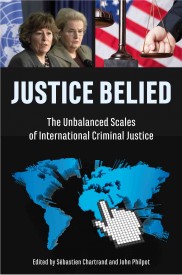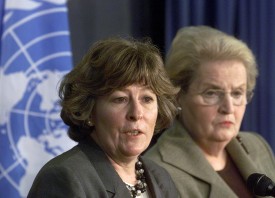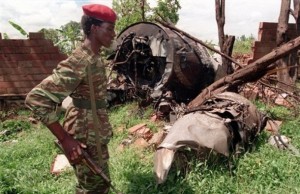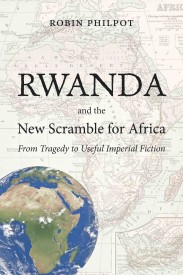Z Magazine has published Edward S. Herman’s review of Justice Belied: The Unbalanced Scales of International Criminal Justice edited by Sébastien Chartrand and John Philpot. According to Herman, co-author with Noam Chomsky of Manufacturing Consent, and with David Peterson of The Politics of Genocide and Enduring Lies, Justice Belied is an “enlightening book” in which the autyors “do a remarkable job of spelling out these sorry conditions and calling for a dismantling of the new International Criminal Justice System and return to the UN Charter and nation-based attention to dealing with injustice.” We are pleased to reproduce the review. To read it in Z Magazine please click here.
 Justice Belied
Justice Belied
The Unbalanced Scales of International Criminal Justice
Edited by Sebastien Chartrand and John Philpot
Baraka Books, 2014, 281 pp.
Review by Edward S. Herman
This enlightening book on international criminal justice is a collection of papers by 15 authors, many involved in the defense of individuals tried by international courts. While the papers differ in tone and detail they are all highly critical of the current international criminal justice system (ICJS). In fact, they make a compelling case that this system is not only flawed but produces serious and systematic injustice. One major theme pressed in a number of chapters is that the ICJS that has emerged in the age of tribunals and “humanitarian intervention” has replaced a real, if imperfect, system of international justice with one that misuses the forms of justice to allow dominant powers to attack lesser countries without legal impediment.
The older real justice system, developed in the wake of the fascist aggressions that culminated in World War II, was expressed in the UN Charter. Its fundamental ideas were the “sovereign equality of all of its members” and the primacy of aggression as criminal international behavior. This was inconvenient to the United States and its close allies, who wanted the freedom to attack other countries without any UN Charter encumbrance, so they restacked the legal deck. All of the ad hoc tribunals set up in recent decades, allegedly to deal with international miscreants, carefully exclude aggression as a punishable crime—they stick to war crimes, human rights violations and that vague entity “genocide,” all of which are easily managed and manipulable with pliable courts and judges (discussed below). This is a key feature of the charters of the International Criminal Tribunal for the Former Yugoslavia (ICTY) and Rwanda (ICTR), the International Criminal Court (ICC), and the assorted other ad hoc tribunals touched upon in Justice Belied. This allowed the United States to attack Yugoslavia and devastate Serbia while using the ICTY to pursue officials and military personnel of the target (Serbia) via this manipulated system of international justice. The 1999 U.S.-NATO attack on Yugoslavia violated the UN Charter, but that fundamental legal document was not enforceable given U.S. power and its veto capability in the Security Council. Even in a gross case such as the 2003 Iraq invasion, the idea of bringing the U.S. and UK to judgment for aggression was unthinkable. The Western powers may well have been tempted to use it for Russia with its fearsome aggression in the Crimea, but they haven’t yet dared, so far confining themselves to verbal condemnations, punitive boycotts, and military threats and deployments.
Another major theme of many authors in Justice Belied is the overriding selectivity of the new international justice system, which in itself “deprives it of legitimacy” (John Philpot)…. The tribunals are organized to deal with targets of the United States and its close allies. Yugoslavia got a tribunal when the United States and Germany wanted to dismantle it, which they did with the help of the ICTY. Rwanda got one because the U.S. and UK wanted to help their client ruler Kagame consolidate his rule with a system of “victor’s justice” in Rwanda.
No tribunals have been established for Israel’s actions in Palestine or Kagame’s mass killings in the Democratic Republic of the Congo (DRC). Numerous authors in Justice Belied stress the remarkable fact of the ICC’s exclusive focus on Africans, with not a single case of charges brought against non-Africans. And within Africa itself the selectivity is notorious—U.S. clients Kagame and Museveni are exempt; U.S. targets Kenyatta, Taylor, and Gadaffi are charged. (See the chapter 1 segment on “Backdoor Attempts to Eternalize Victors Justice,” by Chief Charles A. Taku.)
The selectivity points to another important hostile-to-justice feature of the new system of international criminal justice—namely, that, by the intent of its sponsors, it helps the United States and its allies and clients start, continue and enlarge wars, which follows also from its exclusion of aggression from its crime list. John Philpot quotes a U.S. official’s published explanation of the resort to the (faux) judicial route in the 1999 attack on Yugoslavia as giving a legal gloss to Western power projection; i.e., it serves “like a battering ram in the execution of U.S. and NATO policy.” In the case of the 2011 attack on Libya, the ICC prosecutor’s early indictment of Gadaffi and his associates, based on unverified claims of Viagra distribution and anti-civilian violence, provided excellent cover for the NATO bombing war that resulted in very substantial civilian killings. In the case of Yugoslavia, the ICTY prosecutor brought charges against Milosevic in May 1999, timed well to distract attention from the fact that NATO had begun serious targeting of civilian facilities in Serbia. In Justice Belied there is no hesitation to argue that with the new ICJS we witness “war by other means” (Ramsey Clark).
Another false claim by establishment defenders of the new ICJS is that it will end impunity. But it is clear from the purposeful exclusion of aggression from the crime list and the spectacularly politicized selectivity in the targeting within the new legal structure, that impunity is flourishing. Some of the means by which impunity is assured are pretty crude. Of course, the exclusion of aggression, Nuremberg’s “supreme international crime” from the list is itself pretty crude. Also crude is the U.S.-encouraged inclusion in the Rome statute establishing the ICC a section 98 paragraph 2, which allows bilateral agreements that promise to refuse any transfer of U.S. and its partner’s citizens to the ICC.
The United States has entered dozens of such agreements, but still has failed to sign the Rome agreement, because it holds forth the theoretical possibility that an American might be subject to ICC prosecution. This possibility exists because the ICC is founded on an international agreement, not a tribunal set up by the Security Council where the United States has veto power. The U.S. still arranged for Security Council rights to request action by the ICC, so that in practice its non-membership has not interfered with its dominant influence over the ICC’s work. The hope and expectation of the African states that the ICC would break the pattern of Western and selective impunity has not been met in any way. But despite these biases and limits to universality, Kofi Annan proclaimed that with the ICC we enter a new era of no further impunity: “Now at last….we shall have a permanent court to judge the most serious crimes of concern to the international community as a whole.” In the real world, not “as a whole” but in accordance with Annan’s bosses in Washington.
There was a slight interruption in the pattern of impunity for the United States and its clients with the brief surge in actions by Spanish courts under their laws that permitted Spanish and even non-Spanish victims to bring suits in Spain against non-Spanish criminals who remained free of prosecution in their own countries. Working within this legal system, an International Forum for Truth and Justice in the African Great Lakes Region, comprised of private individual victims and activists, several NGOs, and some public institutions, initiated a study of international crimes perpetrated in Rwanda and the DRC between October 1990 and July 2002, and followed this up by filing a lawsuit in Spain in 2005 based on the massive crimes found there. After several years of investigation, the Spanish court issued warrants in 2008 for the arrest of 40 top officials of the RPF. This caused chaos in the prevailing system of injustice, where no RPF official had been prosecuted anywhere, only Hutu. Some of the details of the Spanish court’s findings, with compelling evidence of the RPF’s responsibility for many thousands of civilian deaths in both Rwanda and the DRC, caused the ICTR prosecutor to respond—very briefly—to RPF crimes; although tellingly, only one week after opening his groundbreaking case the prosecutor reached an agreement with the Kagame government allowing the four RPF men to be tried in Rwanda courts, which soon found them not guilty.
Another consequence of the Spanish action was the mobilization of pressure by the “international community” (i.e., the U.S. and its allies) to get the Spanish government to remove this threat to impunity. The Spanish leadership soon obliged by giving the government authority to bring cases rather than relatively independent courts and victimized parties.
The same happened where Belgian law had allowed a case to be brought there against Ariel Sharon. U.S. threats to remove UN facilities from Belgium led to a quick revision of Belgian law and the termination of that threat to the impunity of war criminals under U.S. and allied protection. The only successful cases brought under Belgian law were ones against two Hutu nuns, given lengthy prison terms for crimes against Tutsi in Rwanda. (Details on these issues are provided in Justice Belied in chapter 13, on “Universal Jurisdiction” by Jordi Palou- Loverdos.)
Much of Justice Belied is devoted to showing that in their regular operations international tribunals have fallen seriously short of recognized judicial standards. This follows from the extreme politicization of these courts, which brings with it compromised choices of prosecutors and judges, and makes for “results-oriented” processes in which the finding of guilt is a foregone conclusion. Many of the prosecutors are vetted by U.S. officials and quite a few of them come from the U.S., UK and Canada.
 Notable was the selection of Louise Arbour, a Canadian lawyer, vetted by Madeleine Albright, as ICTY prosecutor, and later appointed by Kofi Annan to head the UN Commission on Human Rights, replacing Mary Robinson, who had fallen out of U.S. favor. Arbour was the prosecutor who brought the case against Milosevic in May 1999 just as NATO was intensifying its bombing of civilian facilities in Serbia. She was also the ICTR prosecutor who closed down the Hourigan investigation of the shoot-down of Rwanda president Habyiramana’s plane on April 6, 1994, when it appeared that the findings pointed to U.S. client Kagame as the killer. (For details see Herman and Peterson, Enduring Lies: The Rwanda Genocide in the Propaganda System, 20 Years Later.)
Notable was the selection of Louise Arbour, a Canadian lawyer, vetted by Madeleine Albright, as ICTY prosecutor, and later appointed by Kofi Annan to head the UN Commission on Human Rights, replacing Mary Robinson, who had fallen out of U.S. favor. Arbour was the prosecutor who brought the case against Milosevic in May 1999 just as NATO was intensifying its bombing of civilian facilities in Serbia. She was also the ICTR prosecutor who closed down the Hourigan investigation of the shoot-down of Rwanda president Habyiramana’s plane on April 6, 1994, when it appeared that the findings pointed to U.S. client Kagame as the killer. (For details see Herman and Peterson, Enduring Lies: The Rwanda Genocide in the Propaganda System, 20 Years Later.)
U.S. influence in the workings of these international tribunals has been overwhelming, and John Philpot is not alone in Justice Belied in finding the ICJS “an instrument of United States foreign policy.” Only the United States has “Ambassadors At Large For War Crimes,” who rove the world and intervene often and with telling effect, making for politically correct “results-based,” if not real, justice. It is critically important in the case of Rwanda that the United States protects the Kagame dictatorship in its activities at home and abroad (mainly in the DRC).
This has resulted in the subordination of the ICTR to Kagame’s demands and interests, so that only Hutus can be prosecuted, and with judicial abuses almost without limit. Paid witnesses, bullied witnesses, witnesses who revise their testimony according to prosecution needs, very frequent recantations of testimony, notably when the witnesses escape from Kagame jurisdiction, steady violations by prosecutors of their obligations to disclose exculpatory evidence, and the frequent refusal of the courts to reopen trials even in the face of major recantations or disclosures of falsified evidence. (See chapter 9, Beth Lyons, “Prosecutorial Failure to Disclose Exculpatory Material: A Death Knell to Fairness.”)
In a notable instance of Kagame justice, the leader of the chief Rwanda opposition party, Victoire Ingabire, returning to Rwanda after a 16-year stay in the Netherlands, was soon arrested by Kagame, imprisoned, attacked for genocide denial and threatening national security, and was eventually saddled with a 15-year prison term. Her lawyer Peter Erlinder was also briefly detained on similar charges. But Kagame also resorts to murder of oppositional figures: Philpot lists six, but there are more. One of the most enlightening cases is that of Juvenal Uwilingiyimana, a former Rwanda minister living in Belgium. Prosecutor Stephen Rapp, an American, tried to get him to confess to involvement in a genocidal Hutu leader plan, threatening him with a sealed genocide indictment at the ICTR. Uwilingiyimana eventually backed away from agreeing to the desired confession, preferring to go to Arusha and testify before the ICTR, where he would disclose Rapp’s lies and threats. Rapp’s associates warned him that non-cooperation would lead to his nasty death. And, lo and behold, Uwilingiyamana disappeared on November 28, 2005, his mangled body found in a Belgian canal several weeks later. Believing he was in danger, however, he had sent a letter to the Tribunal and various associates outlining the events, lies and threats. This is in a Kagame tradition, but U.S. cooperation and involvement are notable.
Philpot points out that although the various Hutu conspiracies, such as that which Rapp wanted Uwilingyimana to admit to, were rejected regularly by the ICTR, despite its pro-Kagame and pro-U.S. bias, the ICTR’s website continues to propagandize with cartoons and claims of Hutu unwillingness to share power (presumably Kagame was prepared to share power) and a pre-April 6, 1994 conspiracy to massacre Tutsi. As Philpot says, “The ICTR serves as an organ of propaganda in contempt of its own judgments.”
In another revelation on its bias and contempt for law, in recent years the ICTR has transferred prisoners that they have taken into custody to Rwanda for trial there. This outrageous policy has been put in place despite the clear evidence of a completely corrupt and politicized judicial system and in the face of the treatment of Victoire Ingabire. But the U.S. government and mainstream media haven’t noticed or complained. In fact, when ICTR prosecutor Carla Del Ponte tried to advance the prosecution of some RPF personnel in 2003, former ICTR prosecutor and then Ambassador at-large for the U.S., Pierre Prosper, tried to get her to transfer the RPF cases to Rwanda, she refused and was soon fired.
Many chapters in Justice Belied stress the extent to which the heavy hand of the U.S. shaped the character and work of the new international justice system. The system has worked poorly in service to justice, as the authors point out, but U.S. policy has had larger geopolitical and economic aims, and underwriting Kagame’s terror in Rwanda and the DRC and directing the ICC toward selected African targets while ignoring others served those aims. Many of the statutes and much political rhetoric accompanying the new ICJS proclaimed the aim of bringing peace and reconciliation. But this was blatant hypocrisy as the exclusion of aggression as a crime, the selectivity of application, the frequency of applied victor’s justice, and the manifold abuses of judicial processes have made for war, hatred and exacerbated conflict. The authors of Justice Belied do a remarkable job of spelling out these sorry conditions and calling for a dismantling of the new ICJS and return to the UN Charter and nation-based attention to dealing with injustice.
Z
Edward S. Herman is an economist, media critic, and author. He has been contributing a monthly article to Z since its founding in 1988.


 Justice Belied
Justice Belied Notable was the selection of Louise Arbour, a Canadian lawyer, vetted by Madeleine Albright, as ICTY prosecutor, and later appointed by Kofi Annan to head the UN Commission on Human Rights, replacing Mary Robinson, who had fallen out of U.S. favor. Arbour was the prosecutor who brought the case against Milosevic in May 1999 just as NATO was intensifying its bombing of civilian facilities in Serbia. She was also the ICTR prosecutor who closed down the Hourigan investigation of the shoot-down of Rwanda president Habyiramana’s plane on April 6, 1994, when it appeared that the findings pointed to U.S. client Kagame as the killer. (For details see Herman and Peterson, Enduring Lies: The Rwanda Genocide in the Propaganda System, 20 Years Later.)
Notable was the selection of Louise Arbour, a Canadian lawyer, vetted by Madeleine Albright, as ICTY prosecutor, and later appointed by Kofi Annan to head the UN Commission on Human Rights, replacing Mary Robinson, who had fallen out of U.S. favor. Arbour was the prosecutor who brought the case against Milosevic in May 1999 just as NATO was intensifying its bombing of civilian facilities in Serbia. She was also the ICTR prosecutor who closed down the Hourigan investigation of the shoot-down of Rwanda president Habyiramana’s plane on April 6, 1994, when it appeared that the findings pointed to U.S. client Kagame as the killer. (For details see Herman and Peterson, Enduring Lies: The Rwanda Genocide in the Propaganda System, 20 Years Later.)
 Michael Hourigan was a courageous man devoted to finding out the truth about one of the worst tragedies of the 20th century. His interviews and affidavit are absolutely crucial to understanding the Rwandan tragedy. As we approach the twentieth anniversary of the shamelessly trivialized assassination of the two African heads of state, his interviews and affidavits are essential documents that deserve to be widely circulated.
Michael Hourigan was a courageous man devoted to finding out the truth about one of the worst tragedies of the 20th century. His interviews and affidavit are absolutely crucial to understanding the Rwandan tragedy. As we approach the twentieth anniversary of the shamelessly trivialized assassination of the two African heads of state, his interviews and affidavits are essential documents that deserve to be widely circulated.

Facebook